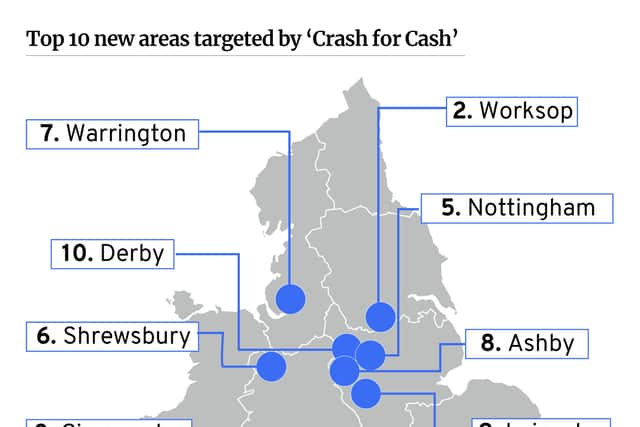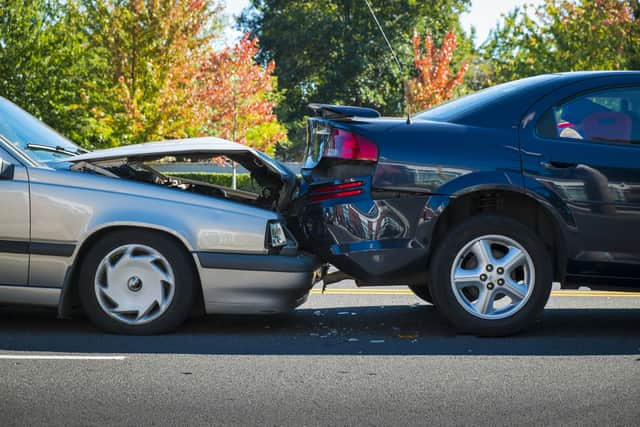Crash for cash scams: How to spot and avoid dangerous driving as emerging hotspots are named
and live on Freeview channel 276
Drivers around the UK are being warned to be on the lookout for crash for cash scammers as the dangerous criminal activity spreads around the country.
Fraud experts have warned that the gangs behind the insurance scams, which involve deliberately causing collisions, are moving out from the well-established hotspots and targeting drivers in previously quiet areas.
Advertisement
Hide AdAdvertisement
Hide AdThe Insurance Fraud Bureau, which tracks crash for cash scams, believes criminals are targeting drivers in new areas in the hope of finding more unsuspecting victims and avoiding detection by shifting their operations further afield.
It has used insurance claims reports from the last 12 months to identify the 10 towns and cities which have seen the sharpest rise in such scams.


Frome, in Somerset, was identified as the area with the fastest-growing problem, ahead of Worksop, in Nottinghamshire, and Cirencester, Gloucestershire.
The latest figures reflect emerging problem areas and build on the IFB’s list of crash for cash hotspots, which identified Birmingham as the worst area in the UK for the dangerous scam, followed by postcodes in Bradford, Manchester, London and Luton.
Advertisement
Hide AdAdvertisement
Hide AdBen Fletcher, director at the IFB, said: “Crash for cash fraudsters are known to evolve their tactics and the latest evidence shows that they’ve started spreading out from prominent crime hotspots to less suspecting towns and cities in the hope that they can avoid detection.
“This change in tactic brings home the fact that no matter where people may live, everyone should be on their guard to these reckless car crash scams. To help us stop cases from rising and bring these fraudsters to justice, we urge drivers to look out for signs of crash for cash scams and to report any evidence of it to us straight away.”


The IFB is investigating 170 incidents linked to these rising hotspots but believes its current inquiries only “scratch the surface” of the problem and is encouraging drivers who think they might have been a victim to report incidents via its Cheatline online or on the phone on 0800 422 0421.
Tom Hill, Detective Chief Inspector at City of London Police’s Insurance Fraud Enforcement Department (IFED), said: “These criminals are reckless and show zero regard for the safety of other road users. It is important to learn the tell-tale signs that often precede an induced collision, as these can protect you from falling victim to this type of fraud. Of course these fraudsters can’t always be avoided, so if you do think you have been targeted, make sure to report your suspicions."
How to spot a crash-for-cash scam
Advertisement
Hide AdAdvertisement
Hide AdCrash for cash scams work in a number of ways but one of the most common and dangerous methods is for criminals to deliberately cause an accident with an innocent driver, often at a roundabout or junction. They then make exaggerated or completely false claims for damage to their vehicle or personal injuries.
Almost 200,000 claims a year are thought to be linked to such scams, costing the insurance industry millions of pounds and pushing up premiums for everyone.
Clues to look out for include:
- The other person driving erratically before the incident, including sharp braking for no reason
- The rear passenger looking out the rear window (advising the driver when the vehicle behind is close)
- The driver starting to move onto a roundabout and then stopping for no reason
- The driver suddenly turning right on a mini-roundabout, after appearing to be travelling straight over
- The driver encouraging you to pull out at a junction but then crashing into you
- The driver handing pre-written information straight after the accident
- The driver seemingly exaggerating their injuries
- The driver acting particularly unphased after the collision
- The driver blaming someone else who was driving erratically in front of them and has since driven off (this could be an example of the scammer using an accomplice)
To avoid such scams, the IFB advises:
- Keep a good distance - 2 seconds in dry conditions, 4 seconds in wet, and up to 20 in snow/ice
- Drive safe and stick to the highway code.
- Look ahead to spot any potential hazards including unusual driving behaviour.
- Focus on vehicles and not just their lights, as fraudsters often disable brake lights.
- Be cautious when pulling out of a side road, especially if encouraged by another driver.
- If other drivers or their passengers are behaving suspiciously, or the condition of their vehicle is poor (such as rear dents), stay calm and keep back.
Comment Guidelines
National World encourages reader discussion on our stories. User feedback, insights and back-and-forth exchanges add a rich layer of context to reporting. Please review our Community Guidelines before commenting.
